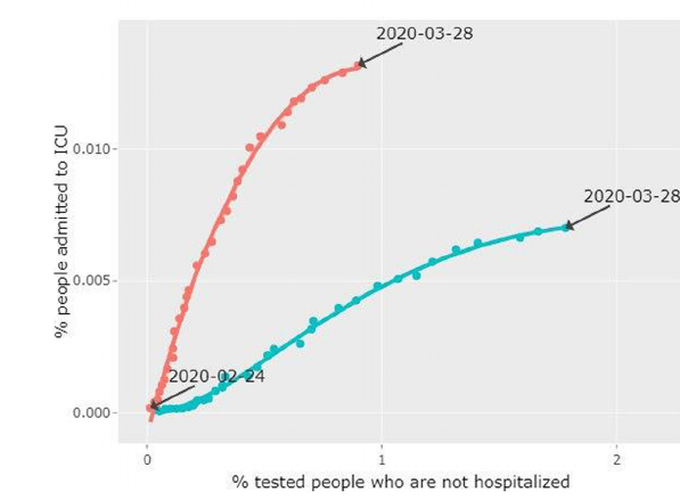Is a more aggressive COVID-19 case detection approach mitigating the burden on ICUs? Some reflections from Italy
 Percentage (%) of subjects not hospitalized who underwent COVID-19 testing vs percentage (%) of subjects admitted to the ICU (calculated on resident population).
Percentage (%) of subjects not hospitalized who underwent COVID-19 testing vs percentage (%) of subjects admitted to the ICU (calculated on resident population).
Is a more aggressive COVID-19 case detection approach mitigating the burden on ICUs? Some reflections from Italy
Abstract
Italy is the first European country in which the COVID-19 epidemic outbreak has spread, starting from two regions in Northern Italy, Veneto, and Lombardia. The outbreak poses a relevant burden on hospital resources, with a marked increase in the intensive care unit (ICU) occupancy rates. It has been hypothesized that the proportion of severe infections that need intensive care could be affected by the testing strategy. At the beginning of the epidemic outbreak (21 February), an extensive testing strategy of both symptomatic and asymptomatic subjects has been adopted in Veneto and Lombardia. However, soon after the starting of the outbreak (27 February), the Italian Ministry of Health introduced restrictions in testing asymptomatic/mild symptomatic subjects. Such a recommendation has been a topic of debate among Italian scientists and policymakers since it has been suggested that also asymptomatic patients seem to transmit the infection. For this reason, different strategies have been adopted at the regional level, thanks to the local autonomy of the regional health services. The Lombardia region adopted the recommendation, while the Veneto region did not apply the restrictions in testing asymptomatic/mild symp- tomatic patients, in line with the strategy adopted by the Republic of Korea. To compare such two testing strategies, we assessed the relationship between the percentage of ICU admissions on the resident population and the percentage of asymptomatic/mild symptomatic subjects tested on the resident population, in Lombardia and Veneto. Analyses are based on official data. The asymptomatic/mild symptomatic subjects tested were obtained by subtracting the daily number of newly hospitalized patients from the total number of tests performed on the same day. The choice of asymptomatic patients instead of the overall number of patients was performed to avoid artifactual collinearity in the two dimensions being analyzed. Smoothing approximation using a loess regression method using polynomials of degree 2 with the alpha parameter set to 1.5 has been fitted. The results are reported in Fig. 1. At the beginning of the observation (24 February), the percentage of asymptomatic/mild symptomatic subjects tested was 0.014% in Lombardia and 0.044% in Veneto, with 0.00019% and 0.00008% ad- missions in ICU in Lombardia and Veneto, respectively. At the 27th of March, the asymptomatic/mild symptomatic subjects tested were 0.83% in Lombardia and 1.66% in Veneto, with 0.01283% and 0.00689% of subjects admitted to the ICU in Lombardia and Veneto, respectively. Such data show a higher percentage of asymptomatic/mild symptomatic subjects tested since the beginning of the outbreak in Veneto, corresponding to a lower percentage of subjects admitted to the ICU. These findings suggest that testing also asymptomatic/ mild symptomatic patients would help reduce the proportion of most severe cases eventually requiring ICU and thus limiting the risk of saturation of ICU units.